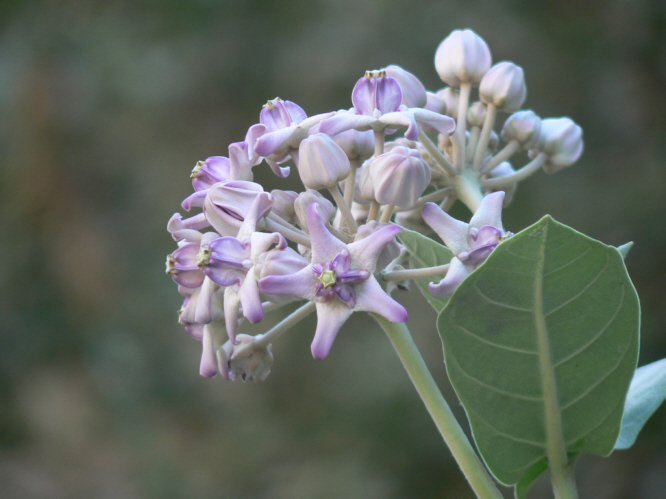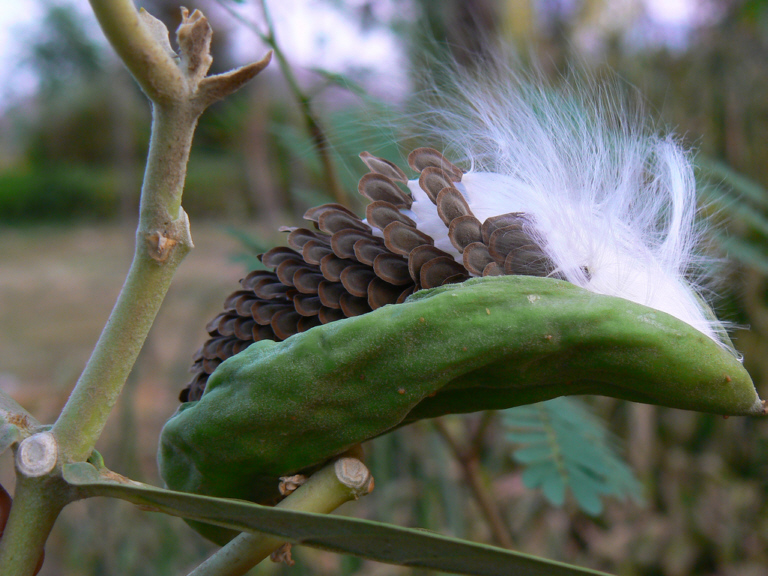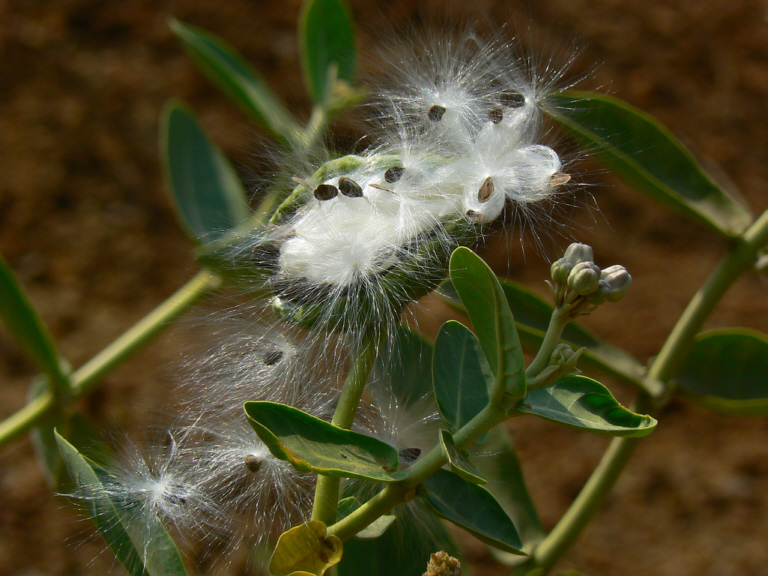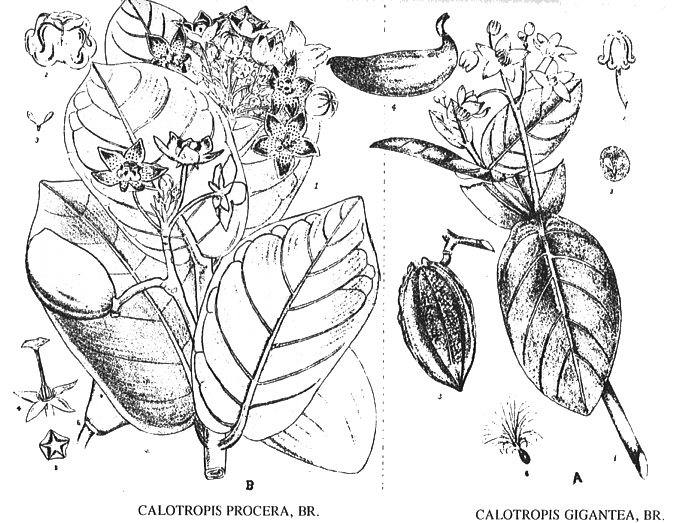

Zitierweise / cite as:
Carakasaṃhitā: Ausgewählte Texte aus der Carakasaṃhitā / übersetzt und erläutert von Alois Payer <1944 - >. -- Anhang A: Pflanzenbeschreibungen. -- Calotropis gigantea (L.) R.Br. -- Fassung vom 2007-06-29. -- URL: http://www.payer.de/ayurveda/pflanzen/calotropis_gigantea.htm
Erstmals publiziert: 2007-03-19
Überarbeitungen: 2007-06-29 [Ergänzungen]; 2007-05-10 [Ergänzungen]; 2007-05-07 [Ergänzungen]
Anlass: Lehrveranstaltung SS 2007
©opyright: Dieser Text steht der Allgemeinheit zur Verfügung. Eine Verwertung in Publikationen, die über übliche Zitate hinausgeht, bedarf der ausdrücklichen Genehmigung des Verfassers
Dieser Text ist Teil der Abteilung Sanskrit von Tüpfli's Global Village Library
WARNUNG: dies ist der Versuch einer
Übersetzung und Interpretation eines altindischen Textes. Es ist keine
medizinische Anleitung. Vor dem Gebrauch aller hier genannten Heilmittel wird
darum ausdrücklich gewarnt. Nur ein erfahrener, gut ausgebildeter ayurvedischer
Arzt kann Verschreibungen und Behandlungen machen!
Falls Sie die diakritischen Zeichen nicht dargestellt bekommen, installieren Sie eine Schrift mit Diakritika wie z.B. Tahoma.
Verwendete und zitierte Werke siehe: http://www.payer.de/ayurveda/caraka0001.htm

Abb.: Calotropis gigantea (L.)
R.Br.
[Bildquelle:
dinesh_valke. --
http://www.flickr.com/photos/dinesh_valke/324713092/. -- Zugriff am
2007-06-29. --
![]()
![]()
![]() Creative
Commons Lizenz (Namensnennung, keine kommerzielle Nutzung, keine
Bearbeitung)]
Creative
Commons Lizenz (Namensnennung, keine kommerzielle Nutzung, keine
Bearbeitung)]

Abb.: Calotropis gigantea (L.)
R.Br.
[Bildquelle:
dinesh_valke. --
http://www.flickr.com/photos/dinesh_valke/443278734/. -- Zugriff am
2007-06-29. --
![]()
![]()
![]() Creative
Commons Lizenz (Namensnennung, keine kommerzielle Nutzung, keine
Bearbeitung)]
Creative
Commons Lizenz (Namensnennung, keine kommerzielle Nutzung, keine
Bearbeitung)]

Abb.: Calotropis gigantea (L.)
R.Br.
[Bildquelle:
dinesh_valke. --
http://www.flickr.com/photos/dinesh_valke/449384437/. -- Zugriff am
2007-06-29. --
![]()
![]()
![]() Creative
Commons Lizenz (Namensnennung, keine kommerzielle Nutzung, keine
Bearbeitung)]
Creative
Commons Lizenz (Namensnennung, keine kommerzielle Nutzung, keine
Bearbeitung)]

Abb.: Calotropis procera und Calotropis gigantea
[Bildquelle: Kirtikar-Basu, ©1918]
Drury:
"Calotropis gigantea (R. Br.) N. O. Asclepiaaceae. Gigantic Swallow-wort, Eng. Yercum, Tam. Yerica, Mal. Nella-jilledoo, Tel. Akund, Beng. Mudar, Ark, Hind.
Description,—Shrub; 6-10 feet; leaves stem-clasping, decussate, oblong-ovate, wedge-shaped, bearded on the upper side at the base, smooth on the upper surface, clothed with woolly down on the under side; segments of corolla reflexed, with revolute edges ; stamineous corona 5-leaved, shorter than the gynostegium; leaflets keel-formed, circinately recurved at the base, incurved and subtridentate at the apex; umbels sometimes compound, surrounded by involucral scales; follicles ventricose, smooth; seeds comose; flowers rose-colour and purple mixed. Fl. All the year.—Dec. Prod. viii. 535.— Asclepias gigantea, Willd.—Roxb. Fl. Ind. ii 30.—Ericu, Rheede, ii. t 31.— Wight Icon. t. 1278.——Peninsula in waste places. Southern provinces.
a—Alba.—Shevet akund, Beng.—Belerica, Mal.—Tella jilledoo, Tel.— Vella-yercum, Tam. — Flowers white, cream-coloured, inodorous.
Medical Uses.—The only difference in the two varieties of this shrub consists in the colour of the flowers. It is commonly to be found in waste ground, among rubbish, ruins, and suchlike places. Of late years the plant has attracted much attention from the many and important uses to which its several properties can be applied. An acrid milky juice flows from every part of the shrub when wounded, and this the* natives apply to medicinal purposes in many different ways, besides preparations of the plant itself in epilepsy, paralysis, bites of poisonous animals, and as a vermifuge. In almost all cutaneous affections, especially in leprosy, it is frequently employed, and much attention has lately been bestowed upon its virtues in the cure of the latter dreadful complaint. The root, bark, and inspissated juice are vised as powerful alteratives and purgatives. Its activity is said to be owing to a principle called Mudarine, discovered by the late Dr Duncan of Edinburgh, which ho found to possess the singular property of congealing by heat, and becoming again fluid on exposure to cold. It is obtained from the tincture of Mudar, the powdered root being macerated in cold rectified spirit After recovering the spirit by distillation, the solution is allowed to cool. A granular resin is then deposited, which is allowed to dry, in order that it may concrete. If water be then applied, the coloured solution from which the resin was deposited dissolves, and the resin remains. This solution is called Mudarine. In taste it is very bitter, soluble in alcohol and cold water, but insoluble in sulphuric ether or olive-oil By experiments made by Dr G. Playfair, the milky juice was found to be a very efficacious medicine in leprosy, lues, taenia, herpes, dropsy, rheumatism, hectic and intermittent fevers, By the Hindoos it is employed in typhus fever and syphilitic complaints with such success as to have earned the title of vegetable mercury. Dr Duncan considered that it agreed in every respect with ipecacuanha, and that from the facility of procuring it, might eventually supersede the latter medicine. The powdered bark is given in doses of 5-6 grains twice daily. It will occasionally produce nausea and vomiting, but such symptoms are renoved by a dose of castor-oil. The root pulverised and made into an ointment is very efficacious in the treatment of old ulcere, so common in the western coast.
The milky juice mixed with common salt is given in toothache, and the juice of the young buds in ear-ache. The leaves warmed and moistened with oil are applied as a dry fomentation in abdominal pains, and, moreover, form a good rubefacient. They are fatal to cattle.—Ainslie. Royle. Pharm. of India.
Economic Uses.—Besides the various uses above enumerated, the root is used in the manufacture of gunpowder charcoal. With the powdered flour the natives adulterate Safflower. The silky floss which surrounds the seeds has been woven into shawls and handkerchiefs, and even paper, besides a soft kind of thread by the natives.
But in addition to its other uses, this plant is valuable from the fine strong fibres with which it abounds. To procure them, the straightest branches are cut and exposed to wither for at least twenty-four hours; on the second and third day they are slightly beaten; the skin is then peeled and the stringy substance between the bark and the wood taken out. They are then dried in the sun. This slow process is necessarily expensive, but if the bark is steeped in water, it becomes discoloured, and cutting will destroy it. Still the fibre is strong, and possessed of many of the properties of Europe flax. It can be spun into the finest thread for sowing or weaving cloth. It resists moisture for a long time. From recent experiments made by Dr Wight, its tenacity, compared with other Indian fibres, is as follows:—
Breaking weight
lb.Yercum, Calotropis gigantea 552 Janapura, or Sunn, Crotalaria juncea 407 Kattalay, Agave Americana 360 Cotton, Gossypium herbaceum 346 Marool, Sanseviera Zeylanica 316 Poolay-munja, Hibiscus cannabinnus 290 Coir, Cocoa nucifera 224 This fibre, however, is too valuable for ordinary cordage, and might fetch a high price in Europe. It is said by good judges to be better for cloth than cordage. It is much used in this country for bowstrings, ropes, bird-nets, and tiger-traps. It has never been cultivated as a cordage plant. It is widely diffused through the southern provinces of the Peninsula; while in the Bellary district and to the north it is replaced by the G. procera, which is equally abundant In the ' Journal of the Society of Arts' it is stated " that Yercum, which much resembles Belgian flax, is well calculated for prime warp yams, and worth £100 per ton." Boyle says that it yields a kind of manna called Mudar-sugar. It has been tried to employ the viscid juice as a caoutchouc, and a great quantity was collected for that purpose. To prepare it, the juice was evaporated in a shallow dish, either in the sun or in the shade; when dry, it may be worked up in hot water with a wooden kneader, as this process removes the acridity of the gum. It becomes immediately flexible in hot water, but is said to become hard in cold water, and is soluble in oil of turpentine, takes impressions, and will no doubt prove a valuable product, either alone or mixed with other substances.
In experiments made in London, Petersburg hemp bore 160 lb. —brown hemp of Bombay and Jubbulpore hemp, 190 lb., which latter was also the strength of the Yercum. Its value in England might probably be reckoned at from £30 to £40 the ton.—Ainslie. Boyle. -Report on Fibres. Jury Rep. Mad. Exhib."
[Quelle: Drury, Heber <1819 - 1872>: The useful plants of India : with notices of their chief value in commerce, medicine, and the arts. -- 2d ed. with additions and corrections. London : Allen, 1873. -- xvi, 512 p. ; 22 cm. -- s.v.]
Dutt:
"CALOTROPIS GIGANTEA AND PROCERA, R. Br. Syn. Asclepias gigantea, Roxb.
Sans. arka, alarka.
Vern. Ākanda, Beng. Mādār, Hind.
Calotropis procera and C. gigantea, both pass by the native name of mādār. C. procera the smaller of the two, prefers the drier climate of the Deccan, the Upper Provinces of Bengal, the Punjab and Scinde; C. gigantea, lower Bengal, the Madras and Malayan Peninsulas, and Ceylon. Sanskrit writers mention two varieties founded upon the colour of the flowers, namely, white, called alarka, and red, called arka. The milky juice, flowers, root-bark and leaves are all used in medicine. The root-bark is said to promote the secretions and to be useful in skin diseases, enlargements of the abdominal viscera, intestinal worms, cough, ascites, anasarca, etc. The milky juice is regarded as a drastic purgative and caustic and is generally used as such in combination with the milky juice of Euphorbia neriifolia. The flowers are considered digestive, stomachic, tonic and useful in cough, asthma, catarrh and loss of appetite.
The leaves mixed with rock salt are roasted within closed vessels, so that the fumes may not escape. The ashes thus produced are given with whey in ascites and enlargements of the abdominal viscera.
The following inhalation is prescribed for cough. Soak the powdered root-bark of arka in its own milky juice and dry. Bougies are prepared with this powder and their fumes inhaled. The root-bark, reduced to a paste with sour congee, is applied to elephantiasis of the legs and scrotum. The milky juices of Calotropis gigantea and Euphorbia neriifolia are made into tents with the powdered wood of Berberis asiatica, for introduction into sinuses and fistula in ano. The milky juice is applied to carious teeth for relief of pain.
Arka taila. Take of prepared sesamum oil, four seers, juice of arka leaves, sixteen seers, and turmeric reduced to a paste, one seer ; boil them together in the usual way. This oil is said to be useful in eczema, and other eruptive skin diseases. Sometimes orpiment is substituted for turmeric is this preparation."
[Quelle: Dutt, Uday Chand: The materia medica of the Hindus / Uday Chand Dutt. With a glossary of Indian plants by George King. -- 2. ed. with additions and alterations / by Binod Lall Sen & Ashutosh Sen. -- Calcutta, 1900. - XVIII, 356 S. -- S. 196 - 198.]